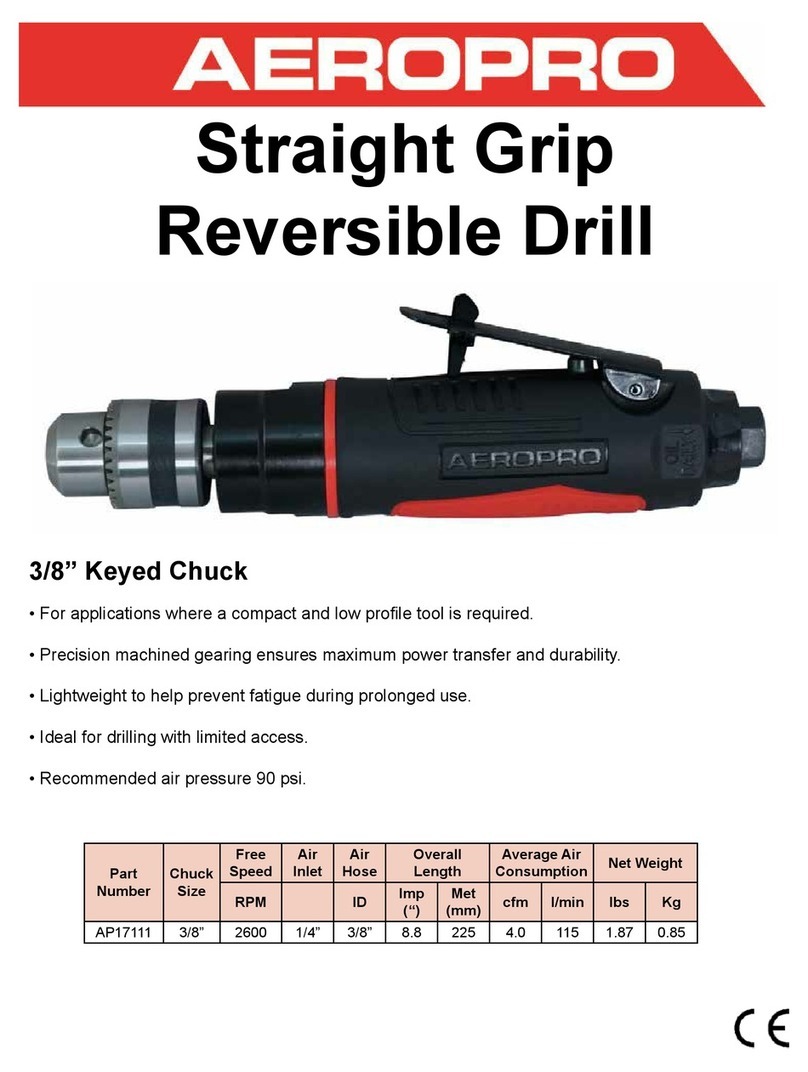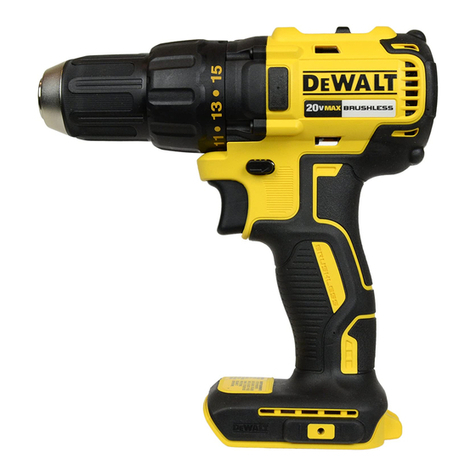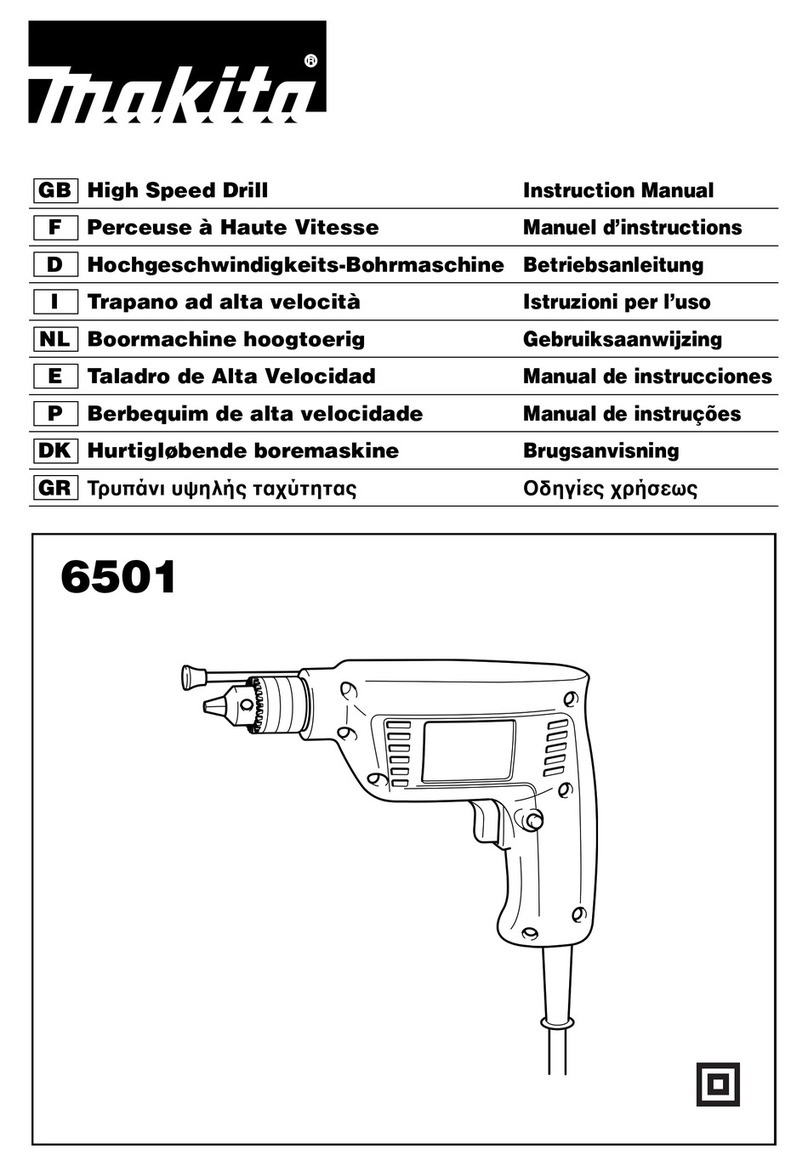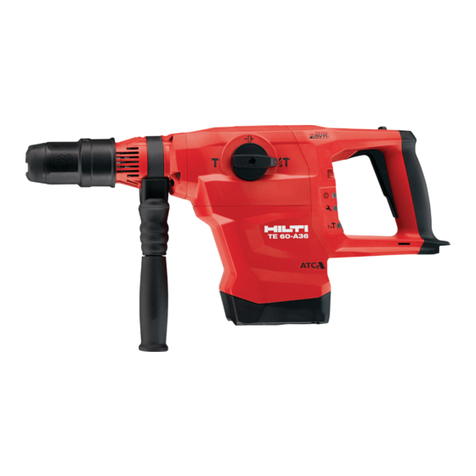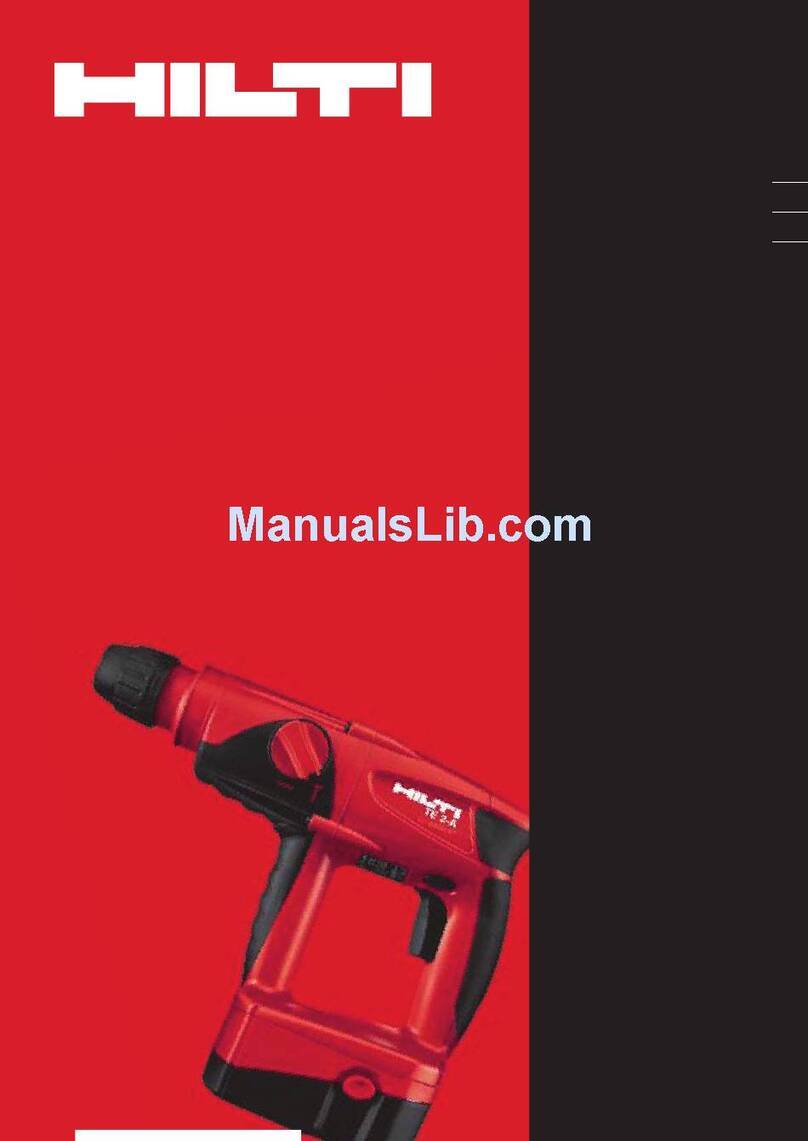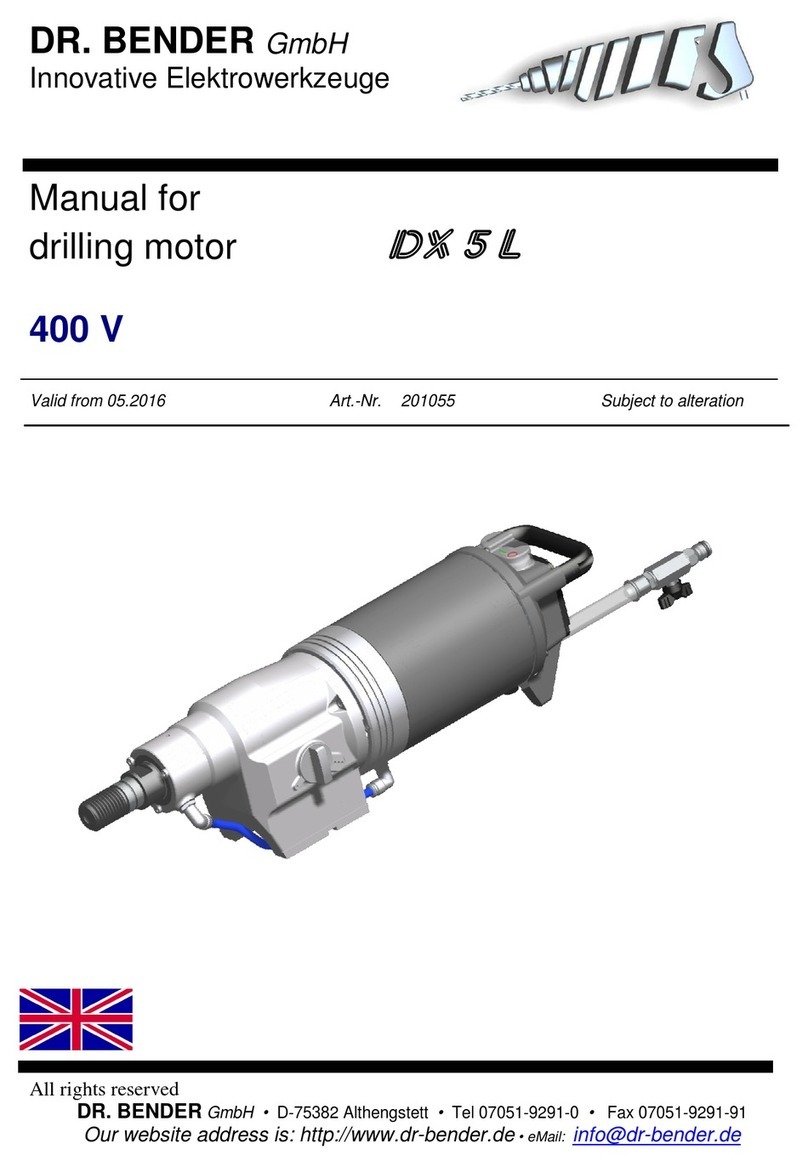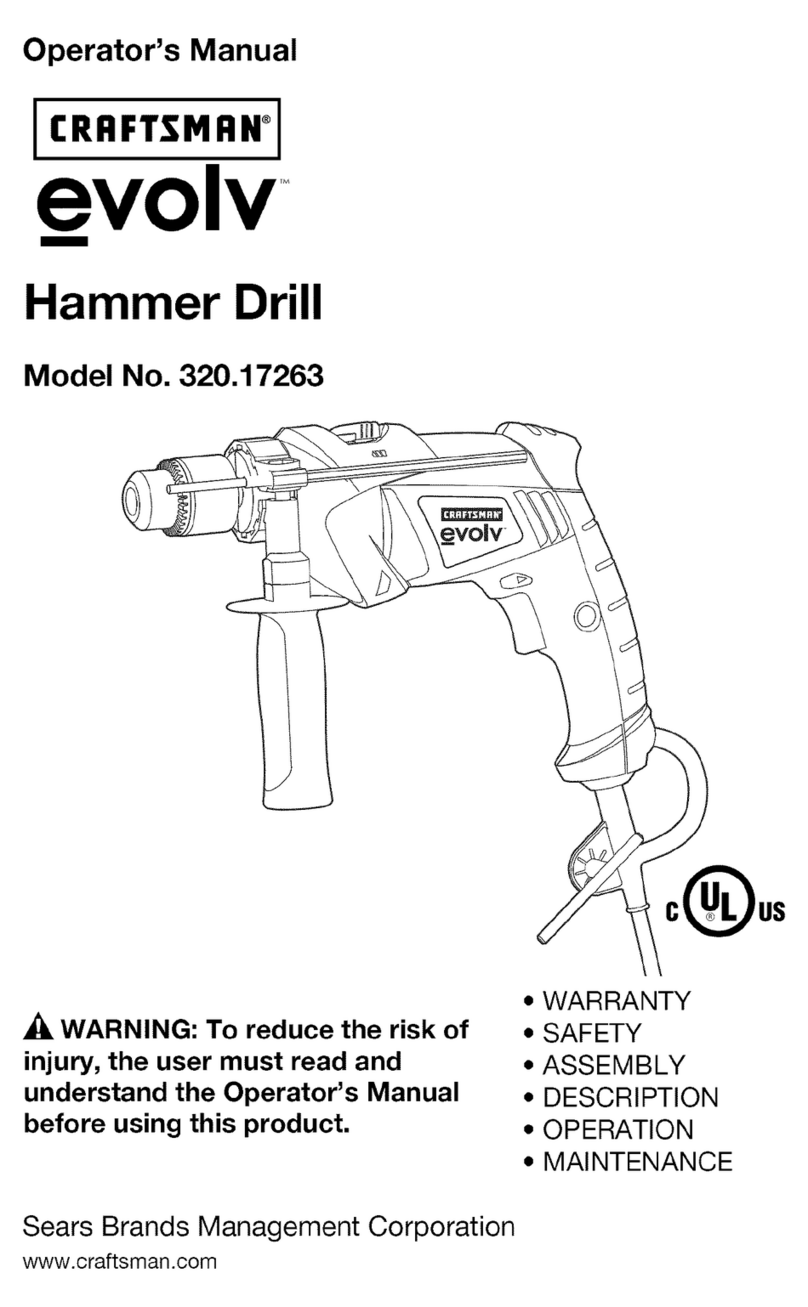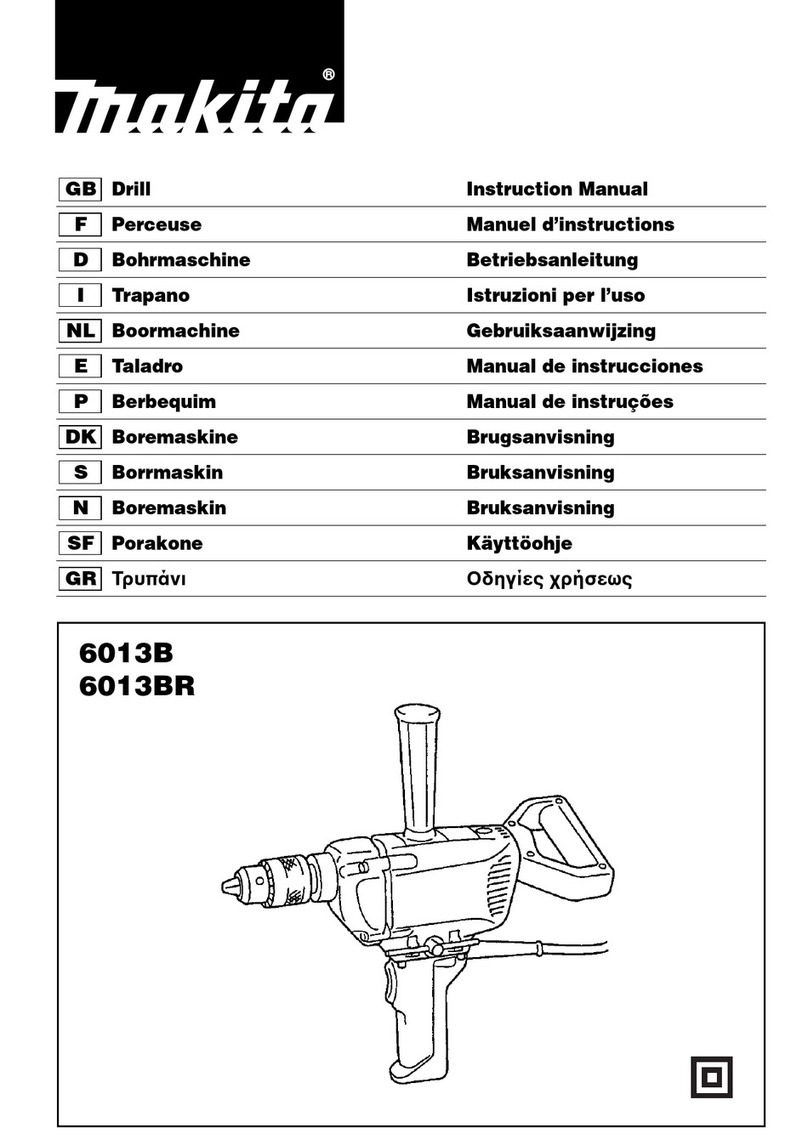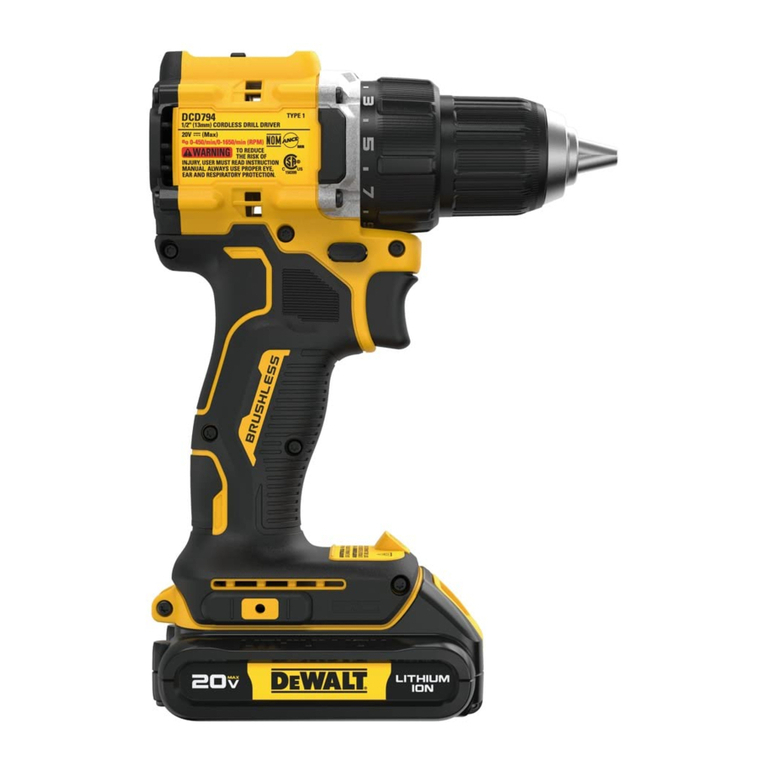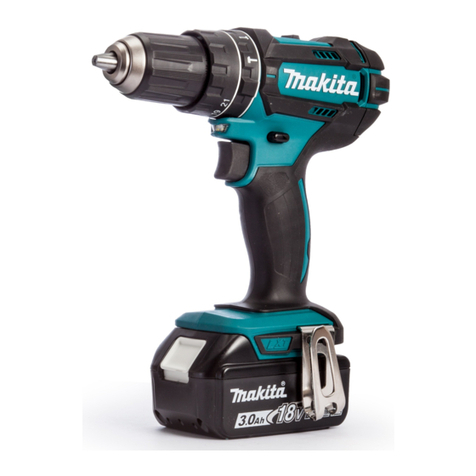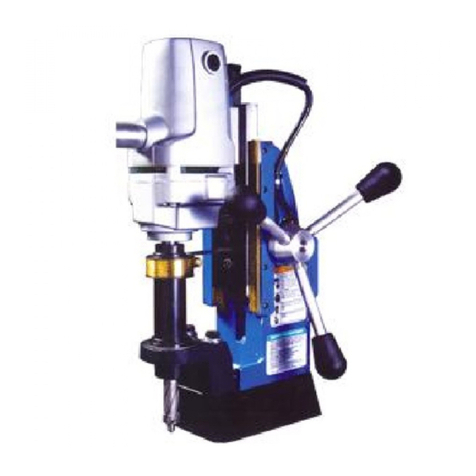Aeropro AP17107 Instruction Manual

Pistol Grip
Reversible Drill
Part
Number
Chuck
Size
Free
Speed
Air
Inlet
Air
Hose
Overall
Length
Average Air
Consumption Net Weight
RPM ID Imp
(“)
Met
(mm) cfm l/min lbs Kg
AP17107 1/2” 700 1/4” 3/8” 7.68 195 4 115 1.18 1.19
• Suited to compact low prole applications.
• Variable speed throttle for easy starts.
• Precision machined gearing ensures maximum power transfer and durability.
• Convenient one hand push button forward/reverse.
• Lightweight helps avoid fatigue during prolonged use.
• Quiet operation with rear exhaust, which directs air away from workplace.
• Ball bearing construction.
• Recommended air pressure 90 psi.
1/2” Keyed Chuck

Operating Instructions
Air Supply
1. Ensure the air valve (or trigger) is in the “OFF” position before connecting to the air supply.
2. You will require an air pressure of 90psi, and an air ow in accordance to the specication.
3. WARNING: Ensure the air supply is clean and does not exceed 90psi while operating the air
tool. Unclean air or too high an air pressure will shorten the product life due to excessive wear
and may be dangerous, causing damage or personal injury.
4. Drain the air tank daily. Water in the air line will damage the air tool.
5. Clean air inlet lter weekly.
6. Line pressure should be increased to compensate for unusually long air hoses (over 8 metres).
The hose diameter should be 3/8” I.D.
7. Keep hose away from heat, oil and sharp edges. Check hose for wear and make certain that all
connections are secure.
Lubrication
An in-line lter-regulator-lubricator with automatic drain is recommended (Fig 1.) as it increases the
tool life and keeps the tool in sustained operation.
The in-line lubricator should be regularly checked and lled with air tool lubrication oil. Excessive
amounts of oil should be avoided.
Fig 1.
Tool
Quick
Connector
Quick
Coupler
Air Hose
Lubricator
Regulator
(0 - 8.5 Bar)
Air
Compressor
Filter
Quick
Connector
Quick
Coupler
Shut-o
Valve
Description
Designed for drilling, honing and hole sawing and other heavy duty applications.
Reversible and keyless air drill.
Durable lightweight aluminium housing.
Variable speed trigger.
Hand exhaust reduces noise and directs air away from work surfaces.

In the event that it becomes necessary to store the tool for an extended period of time (overnight,
weekend, etc.) lubricate the tool generously. The tool should be run for approximately 30 seconds
to ensure that the oil has been evenly distributed throughout the tool. The tool should be stored in a
clean and dry environment.
It is most important that the tool be properly lubricated by keeping the air line lubricator lled
and correctly adjusted. Insufcient lubrication will affect tool performance and parts will wear
prematurely.
Use the correct lubricant in the air line lubricator. The lubricator should be a low air
ow or changing air ow type, and should remain lled to the correct level. Use only
recommended lubricants, specially made for pneumatic applications. Substitutes may harm the
rubber compounds in the tools O-rings and other rubber parts.
IMPORTANT: If a lter-regulator-lubricator is not installed on the air system, air operated tools should
be lubricated at least once a day or after 2 hours work with 2 to 6 drops of oil, depending on the work
environment, directly through the male tting in the tool housing.
Operating Instructions
Loading and Operation
WARNING: Ensure you read, understand and apply safety instructions before use.
1. Connect the air tool to the air hose.
2. Press the trigger to operate the tool.
3. To change direction push the button at the top of the handle. Direction of “R” for reverse and “F”
for forward.
4. The ow of air may be regulated by adjusting the ow valve at the base of the handle.
5. Ensure the air supply is clean and does not exceed 90psi while operating the air tool. Unclean
air or too high an air pressure will shorten the product life due to excessive wear and may be
dangerous, causing damage or personal injury.
DO NOT allow air tool to free run for an extended period of time as this will shorten its life.
Maintenance
WARNING: Disconnect air tool from air supply before changing accessories, servicing or
performing maintenance. Replace or repair damaged parts. Use genuine parts only. Non-authorised
parts may be dangerous.
1. Lubricate the air tool daily with a few drops of air tool oil, dripped into the air inlet.
2. Loss of power or erratic action may be due to the following:
a) Excessive strain on the air line. Moisture or a restriction in the air pipe.
b) Grit or gum deposits in the air tool. If your model has an air strainer (located in the area of
the air inlet), remove the strainer and clean it.
3. When not in use disconnect from air supply and store in a safe, dry, childproof location.

Operating Instructions
Problems Possible Causes Remedies
If tool runs at normal
speed, but loses
speed under load
Motor parts worn Lubricate clutch housing.
Cam clutch worn or sticking
due to lack of lubricant
Check for excess clutch oil. Clutch
cases need only be half full. Overlling
can cause drag on high speed clutch
parts, i.e. a typical oiled/lubricated air
tool requires 1⁄2 ounce of oil
GREASE LUBRICATED: Heat usually
indicates insufcient grease in cham-
ber. Severe operating conditions may
require more frequent lubrication
If tool runs slowly
and air ows lightly
from exhaust
Motor parts jammed with dirt
particles
Check air inlet lter for blockage
Pour air tool lubricating oil into air inlet
as per instructions
Power regulator in closed
position
Operate tool in short bursts quickly
reversing rotation back and forth
where applicable
Air ow blocked by dirt Repeat above if needed
If tool will not run
and air ows freely
from exhaust
One or more motor vanes
stuck due to material build
up
Pour lubrication oil into the tool air inlet
Operate tool in short bursts of forward
and/or reverse rotation where
applicable
Tap motor housing gently with plastic
mallet
Disconnect supply. Free motor by
rotating drive shank manually where
applicable
If tool will not shut
off
O-rings throttle valve
dislodged from seat inlet
valve
Replace O-ring
Trouble Shooting
The following table details the common operating system with problem and solutions. Please read
the table carefully and follow it.
WARNING: If any of the following symptoms appear during your operating, stop using the tool
immediately, or serious personal injury could result. Only qualied persons or an authorised service
centre can perform repairs or replacement of tool.
Disconnect tool from air supply before attempting repair or adjustment. When replacing O-rings or
cylinder, lubricate with air tool oil before assembly.

Safety Rules and Hazards
Residual Risks
Even when the tool is used as prescribed it is not possible to eliminate all residual risk factors.
The following hazards may arise in connection with the tool’s construction and design:
1. Damage to lungs if an effective dust mask is not worn.
2. Damage to hearing if effective hearing protection is not worn.
3. Health defects resulting from vibration emission if the power tool is being used over
longer period of time or not adequately managed and properly maintained.
4. Damage to eyes if sufcient eye protection is not worn.
Important Safety Rules
1. Follow all workshop safety rules, regulations, and conditions when using air tools.
2. Do not wear watches, rings, bracelets or loose clothing when using air tools.
3. WARNING: Disconnect from air supply before changing accessories or servicing.
4. Maintain the air tool in good condition and replace any damaged or worn parts. Use genuine
parts only. Non-authorised parts may be dangerous.
5. WARNING: Check correct air pressure is maintained and not exceeded. 90psi recommended.
6. Keep air hose away from heat, oil and sharp edges. Check air hose for wear before each use
and ensure that all connections are secure.
7. Only use accessories (sockets, drills, chisels etc) which are specically designed for use with
an air tool.
8. Wear approved safety eye/face shield, ear defenders and hand protection.
9. WARNING: Due to the possible presence of asbestos dust from brake linings, when working
around vehicle brake systems, ensure suitable respiratory protection is worn.
10. Maintain correct balance and footing. Ensure the oor is not slippery and wear non-slip shoes.
11. Keep children and non-essential persons away from the working area.
12. DO NOT use the air tool for a task it is not designed to perform.
13. DO NOT use air tool if damaged or thought to be faulty.
14. DO NOT use the air tool unless you have been instructed in its use by a qualied person.
15. DO NOT carry the air tool by the air hose.
16. DO NOT direct air from the air hose at yourself or others.
17. When not in use disconnect from air supply and store in a safe, dry, childproof location.

General Safety Rules
1. For multiple hazards, read and understand the safety instructions before installing, operating,
repairing, maintaining, changing accessories on, or working near the power tool. Failure to do
so can result in serious bodily injury.
2. Only qualied and trained operators should install, adjust or use the power tool.
3. Do not modify the power tool. Modications can reduce the effectiveness of safety measures
and increase the risks to the operator.
4. Do not discard the safety instructions; give them to the operator.
5. Do not use the power tool if it has been damaged.
6. Tools shall be inspected periodically to verify that the ratings and markings required by this part
of ISO 11148 are legibly marked on the tool. The employer/user shall contact the manufacturer
to obtain replacement marking labels when necessary.
Safety Rules and Hazards
Projectile Hazards
1. Failure of the workpiece, of accessories or even of the inserted tool itself can generate
high-velocity projectiles.
2. Always wear impact-resistant eye protection during the operation of the power tool. The grade
of protection required should be assessed for each use.
3. Ensure that the workpiece is securely xed.
Entanglement Hazards
1. Entanglement hazards can result in choking, scalping, and/or lacerations if loose clothing,
personal jewellery, neckwear, hair or gloves are not kept away from the tool and accessories.
2. Gloves can become entangled with the rotating drive, causing severed or broken ngers.
3. Rotating drive sockets and drive extensions can easily entangle rubber-coated or
metal-reinforced gloves.
4. Do not wear loose-tting gloves or gloves with cut or frayed ngers.
5. Never hold the drive, socket or drive extension.
6. Keep hands away from rotating drives.
Repetitive Motion Hazards
1. When using a power tool for, the operator can experience discomfort in the hands, arms,
shoulders, neck, or other parts of the body.
2. While using a power tool, the operator should adopt a comfortable posture whilst maintaining
secure footing and avoiding awkward or off-balanced postures. The operator should change
posture during extended tasks, which can help avoid discomfort and fatigue.
3. If the operator experiences symptoms such as persistent or recurring discomfort, pain,
throbbing, aching, tingling, numbness, burning sensations or stiffness, these warning signs
should not be ignored. The operator should tell the employer and consult a qualied health
professional.

Operating Hazards
1. The use of the tool can expose the operators hands to hazards including crushing, impacts,
cuts, abrasions and heat. Wear suitable gloves to protect hands.
2. Operators and maintenance personnel shall be physically able to handle the bulk, weight and
power of the tool.
3. Hold the tool correctly; be ready to counteract normal or sudden movements and have both
hands available.
4. Maintain a balanced body position and secure footing.
5. Release the start-and-stop device in the case of an interruption of the energy supply.
6. Use only lubricants recommended by the manufacturer.
7. Do not use in conned spaces and beware of crushing hands between tool and workpiece,
especially when unscrewing.
Safety Rules and Hazards
Accessory Hazards
1. Disconnect the power tool from the energy supply before tting or changing the inserted tool or
accessory.
2. Avoid direct contact with the inserted tool during and after use, as this increases the risk of cuts,
burns or vibration injuries.
3. Use only sizes and types of accessories and consumables that are recommended by the
manufacturer.
4. Use only air tool rated sockets in good condition, as poor condition or hand sockets and
accessories used with air tools can shatter and become a projectile.
Workplace Hazards
1. Slips, trips and falls are major causes of workplace injury. Be aware of slippery surfaces
caused by the use of the tool and also of trip hazards caused by the air line or hydraulic hose.
2. Proceed with care in unfamiliar surroundings. Hidden hazards, such as electricity or other utility
lines can exist.
3. The power tool is not intended for use in potentially explosive atmospheres and is not insulated
against coming into contact with electric power.
4. Make sure there are no electrical cables, gas pipes, etc. that can cause a hazard if damaged
by use of the tool.

Dust and Fume Hazards
1. Dust and fumes generated when using power tools can cause ill health (for example, cancer,
birth defects, asthma or dermatitis); risk assessment and implementation of appropriate
controls for these hazards is essential.
2. Risk assessment should include dust created by the use of the tool and the potential for
distributing existing dust.
3. Direct the exhaust to minimise disturbance of dust in a dust lled environment.
4. Where dust or fumes are created, the priority shall be to control them at the point of emission.
5. All integral features or accessories for the collection, extraction or suppression of airborne
dust or fumes should be correctly used and maintained in accordance with the manufacturer’s
instructions.
6. Use respiratory protection in accordance with employer’s instructions and as required by
occupational health and safety regulations.
Safety Rules and Hazards
Noise Hazards
1. Unprotected exposure to high noise levels can cause permanent, disabling, hearing loss and
other problems, such as tinnitus (ringing, buzzing, whistling or humming in the ears).
2. Risk assessment and implementation of appropriate controls for these hazards is essential.
3. Appropriate controls to reduce the risk may include actions such as damping materials to
prevent workpieces from “ringing”.
4. Use hearing protection in accordance with employer’s instructions and as required by
occupational health and safety regulations.
5. Operate and maintain the power tool as recommended in the instruction handbook, to prevent
an unnecessary increase in noise levels.
6. If the power tool has a silencer, always ensure it is in place and in good working order when the
power tool is operating.

Vibration Hazards
1. Exposure to vibration can cause disabling damage to the nerves and blood supply of the hands
and arms.
2. Keep the hands away from the nutrunner sockets.
3. Wear warm clothing when working in cold conditions and keep your hands warm and dry.
4. If you experience numbness, tingling, pain or whitening of the skin in your ngers or hands, stop
using the power tool, tell your employer and consult a physician.
5. Operate and maintain the power tool as recommended in the instruction handbook, to prevent
an unnecessary increase in vibration levels.
6. Do not use worn or ill-tting sockets or extensions, as this is likely to cause a substantial
increase in vibration.
7. Select, maintain and replace the consumable/inserted tool as recommended in the instruction
manual, to prevent an unnecessary increase in vibration levels.
8. Sleeve ttings should be used where practicable.
9. Support the weight of the tool in a stand, tensioner or balancer, if possible.
10. Hold the tool with a light but safe grip, taking account of the required hand reaction forces,
because the risk from vibration is generally greater when the grip force is higher.
Safety Rules and Hazards
Other Aeropro Drill manuals


